For every brushstroke they make, there’s so much to learn from our Indian Chitrakars, but if there’s one technique that stands tall, it's the Kalamkari art form.
Rooted in the age-old traditions of Andhra Pradesh, Kalamkari printing is one such method that is not just known for its beauty but also admired for the soul it carries. Kalamkari prints bring mythology, nature, and heritage onto the fabric in a way that pieces turn into a pure work of art that is wearable. But it’s not just about art—it’s about choosing conscious fashion, glorifying cultural narrative and embracing the timeless grace of Kalamkari fabric.
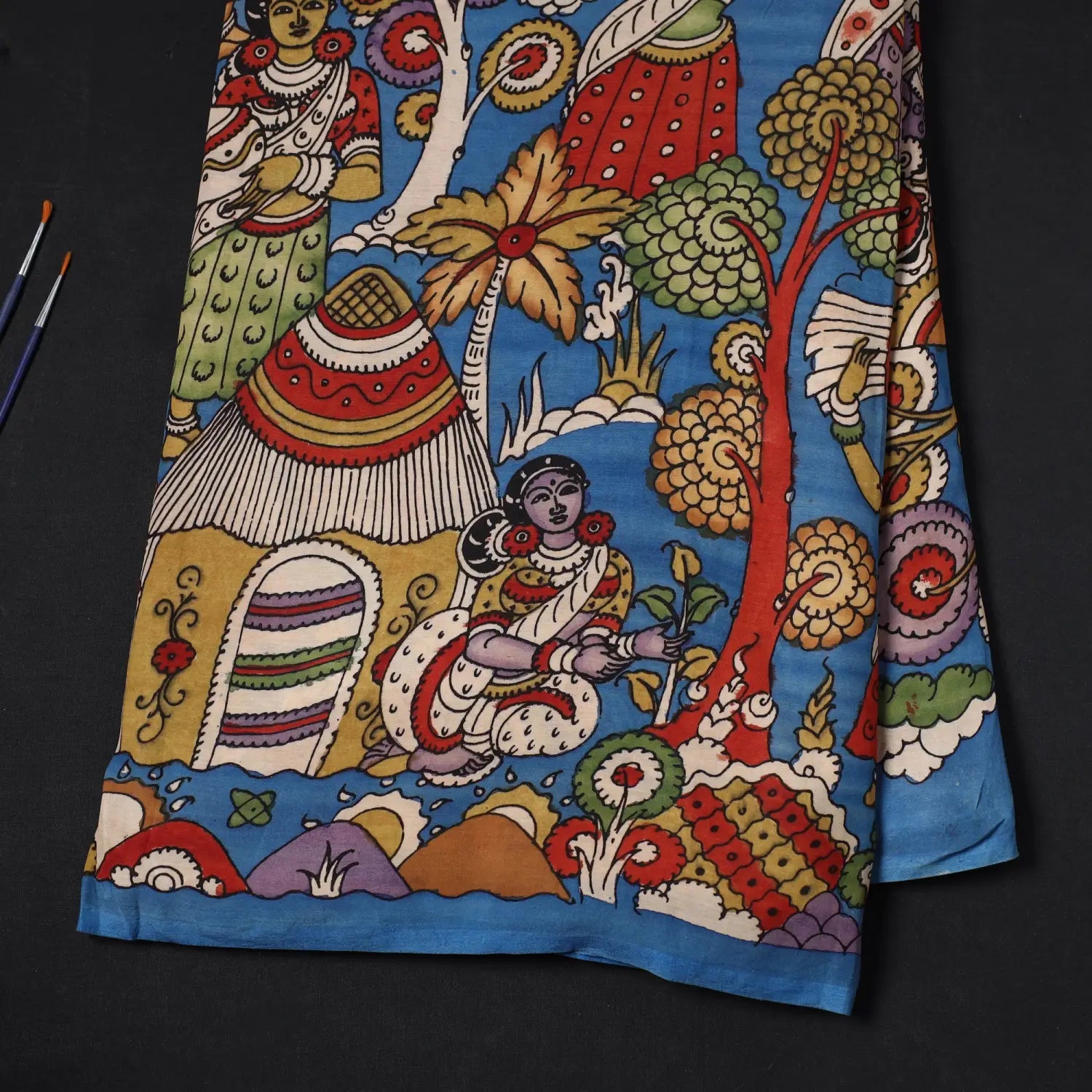
We welcome you to iTokri, and this is our Kahani!
Whether you want to add a pop of colour to your closet with Kalamkari sarees or are looking for pieces rooted in tradition, Kalamkari craft items from iTokri will let you do it all! Come along as we explore what truly makes Kalamkari art special and why it gets all the hype of this world.
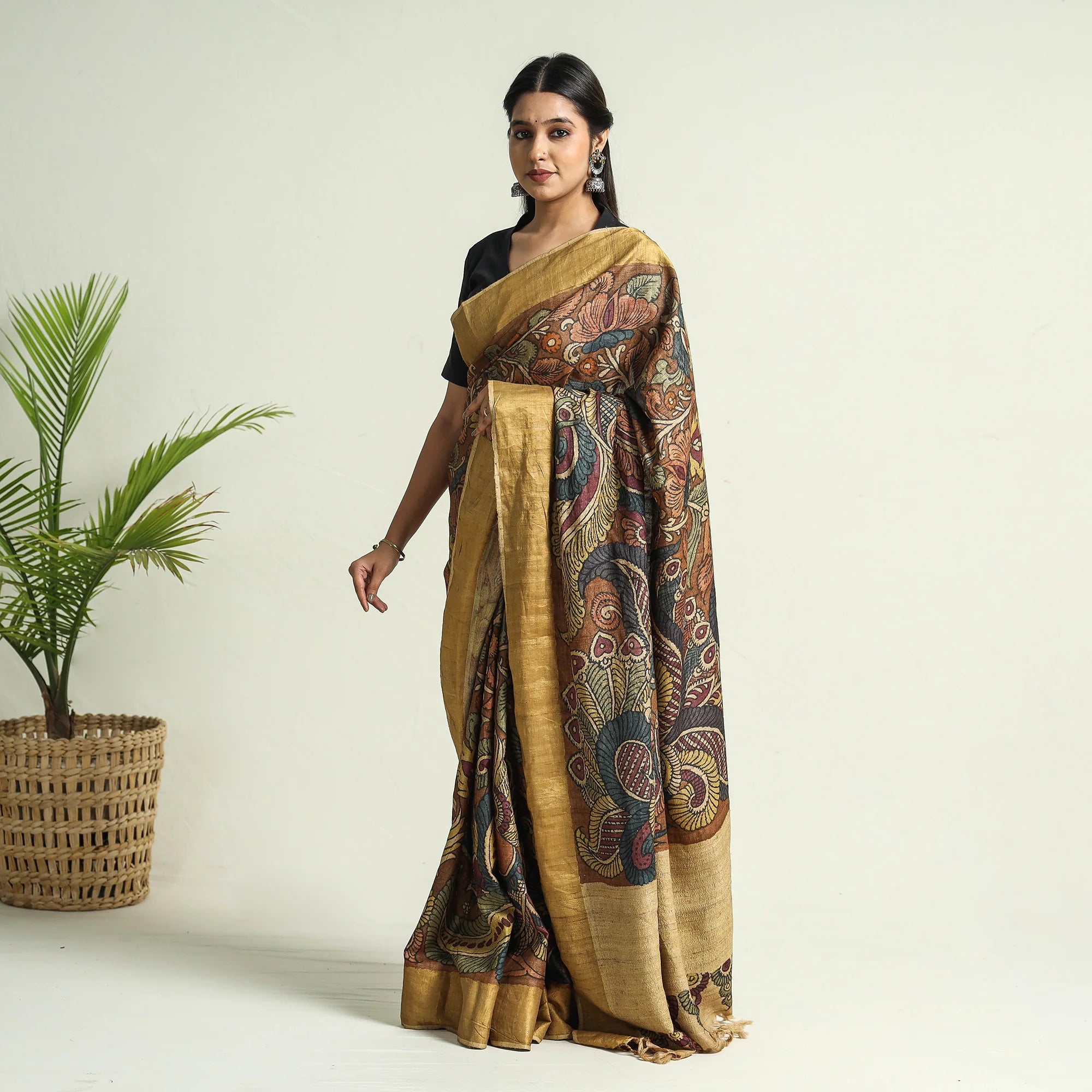
What Is Kalamkari
The word “Kalamkari” is derived from the Persian words ‘kalam’ (pen) and ‘kari’ (craftsmanship), literally meaning pen work. Simply put, it’s the art of storytelling with a pen. This pen, traditionally, is made from bamboo and is used to paint delicate patterns and mythological tales onto fabric using natural, plant-based dyes.
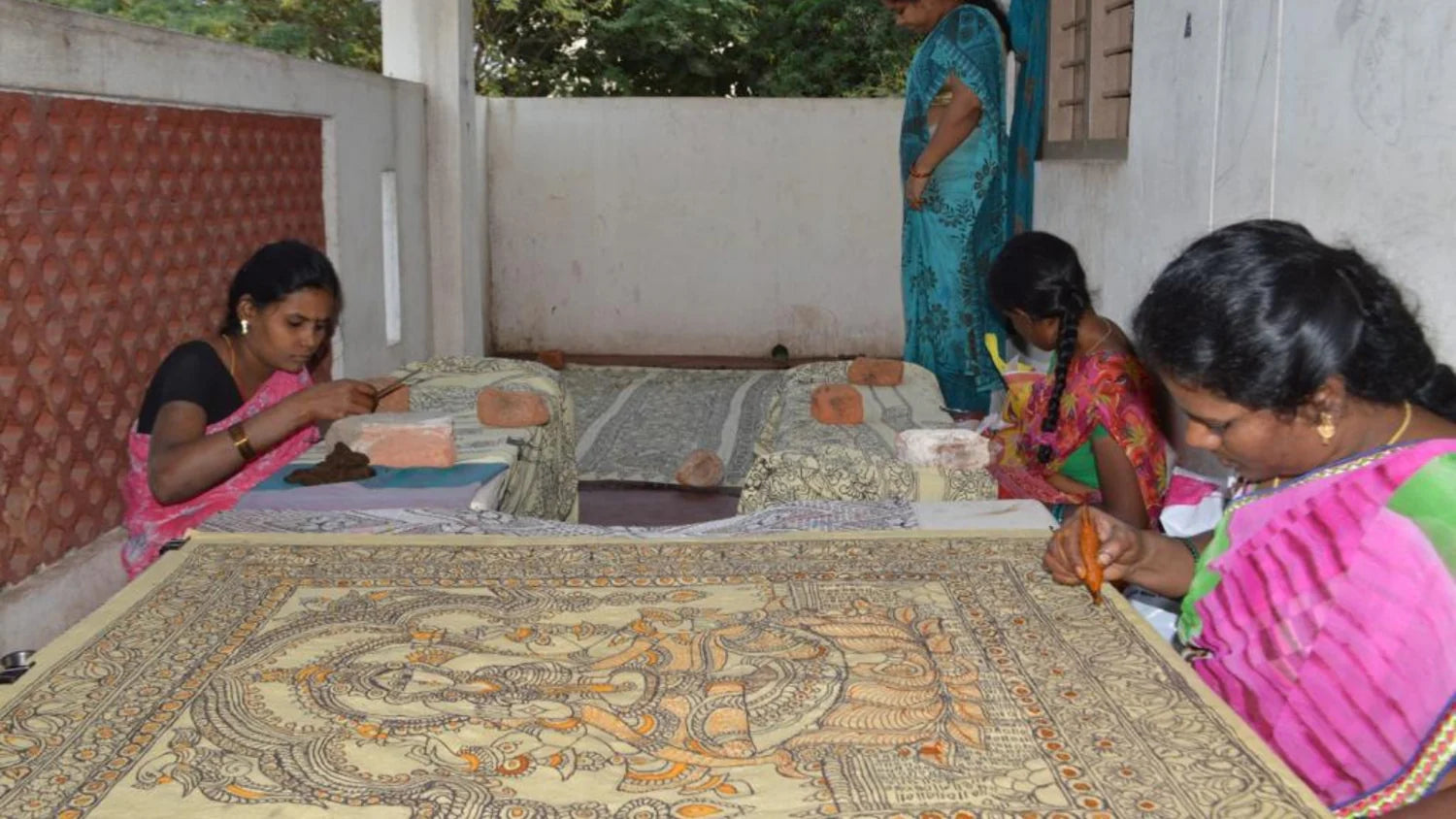
These colours are drawn from roots, leaves, flowers, and mixed with minerals like iron and alum to make them long-lasting. Usually set against an off-white base, the colours of Kalamkari prints shine bright and get even better with each wash. As it stays true to its roots, Kalamkari handicrafts strictly avoid synthetic dyes or chemicals.
The Rich History of Kalamkari
As per historians, Kalamkari is a traditional Indian art form that dates back over 3000 years. (1) Before it became a fabric trend, Kalamkari art was a spiritual practice, an offering, and an art form rooted in tradition. Let’s travel back and learn about the rich history of Kalamkari:
1. Kalamkari Origin
-
The origins of Kalamkari date back over 3,000 years, with evidence found during the Indus Valley Civilisation. This beautiful art form has its roots in ancient India, where it was used to tell stories from Hindu mythology.
-
There was a time when artisans meticulously painted scenes from epic tales like the Ramayana and Mahabharata on fabric.
-
During those days, Kalamkari art was a significant part of religious and ceremonial life. The detailed Kalamkari patterns in this Kalamkari fabric drew the attention of Mughal emperors and the Golconda Sultanate.
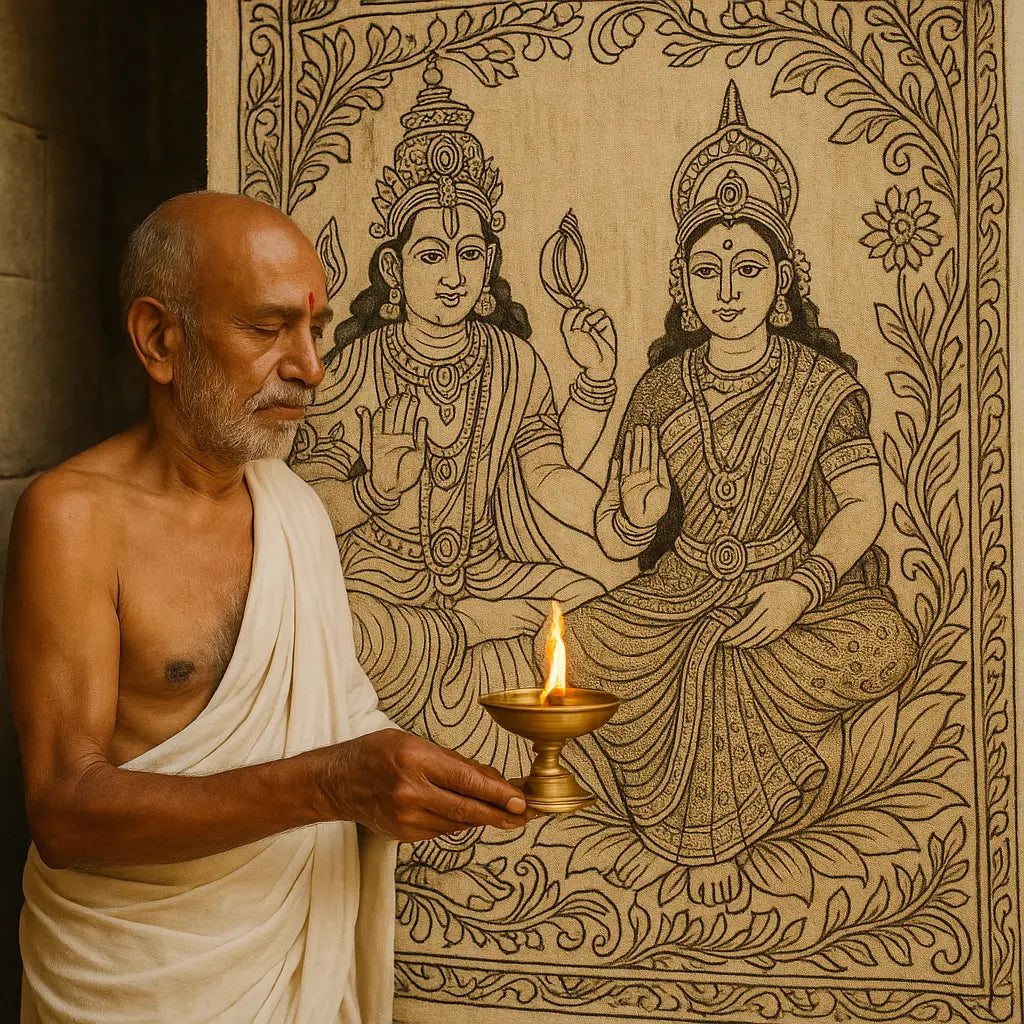
2. Evolution Of Kalamkari Over Time
-
It was initially used to create holy tapestries and temple hangings, but as time went on, Persian influences were absorbed into the art form, leading to the creation of new forms and methods.
-
Eventually, it was divided into Machilipatnam, Or Pedana, and Srikalahasti, two separate forms. The main technique used in Srikalahasti Kalamkari is hand painting. The artists utilise a tool called a "kalam," which resembles a pen, to paint complex designs directly into fabric.
-
However, to produce their lovely, repeating designs, the Machilipatnam style of Kalamkari, also known as Pedana Kalamkari, uses block printing using wooden stamps.
Differentiating Features of Two Popular Kalamkari Crafts - Srikalahasti and Machilipatnam
Think of Srikalahasti and Machilipatnam as siblings—bonded by tradition, but each with a distinct voice. Let’s break down the beauty of Srikalahasti and Machilipatnam Kalamkari.
|
Aspect |
Srikalahasti Style |
Machilipatnam Style |
|
Technique |
All made by hand with a pen, also known as a kalam (a pen-like bamboo instrument) |
Block-printed using carved wooden blocks |
|
Design Theme |
Themed on mythology, and epic stories like the Ramayana & Mahabharata |
Floral motifs, animals, paisleys, and geometric designs |
|
Process |
Drawn entirely freehand with a high level of detail |
Uses pre-carved blocks for faster, repeatable patterns |
|
Region of Origin |
Roots from Srikalahasti, Andhra Pradesh |
Roots from Machilipatnam, Andhra Pradesh |
|
Artisan Skill |
Great emphasis on drawing and storytelling |
Skilled block carving and stamping |
|
Visual Style |
Narrative panels, detailed figures, both human and divine. |
Symmetrical and repeating motifs |
|
Time Taken |
Very time-consuming (days to weeks per piece) |
Faster production (for lengths of fabric) |
|
Uses |
This Kalamkari art is used for wall hangings, sarees, suits, footwear and accessories for women. |
Machilipatnam Kalamkari is used in dress materials, dupattas, and handmade home decor items. |
Unique Features of Kalamkari
Here’s what makes Kalamkari prints stand out:
1. Hand Painted and Block Painted Designs
-
One of the coolest things about Kalamkari crafts is how they are made. Kalamkari art produces complex, repeating patterns that give every piece a distinctive appearance.
-
These elaborate patterns frequently use geometric shapes, floral themes, or mythological images to tell tales. However, the Machilipatnam style of Kalamkari prints uses hardwood blocks that have been dipped in organic dyes.
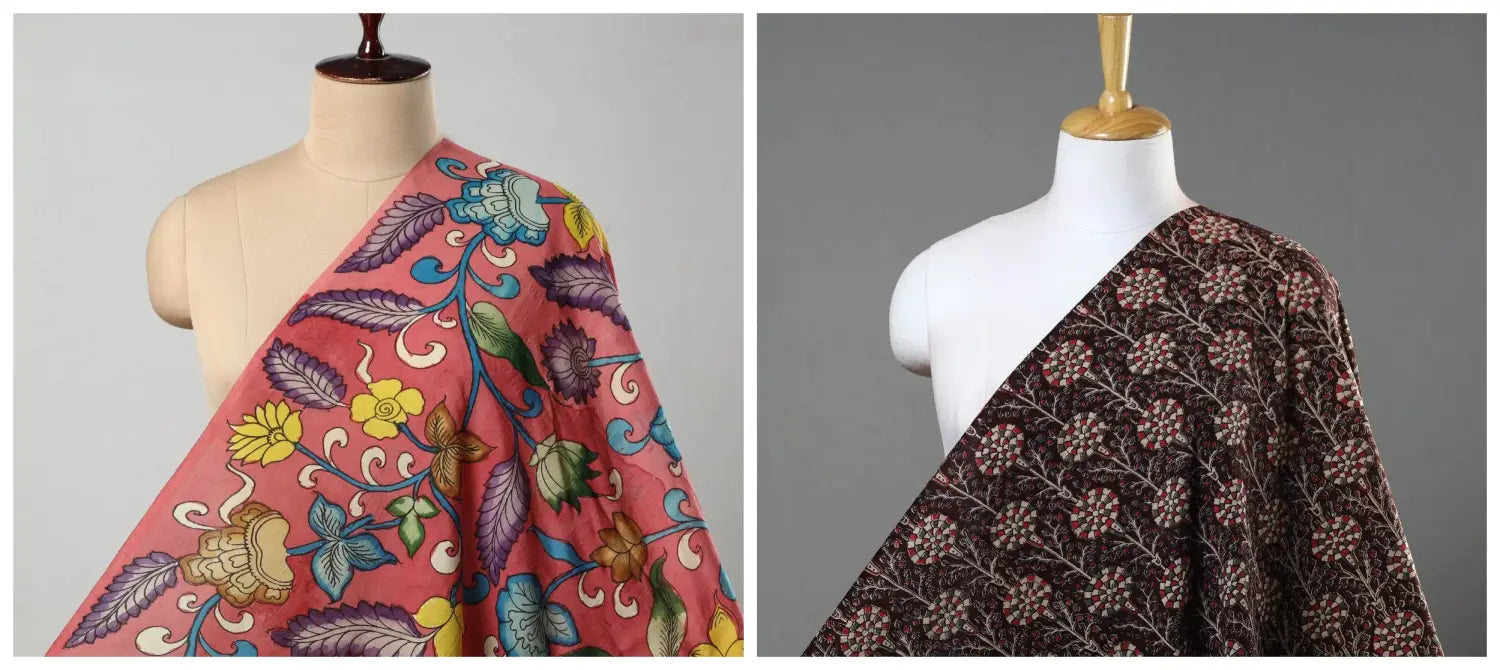
2. Use Of Natural Dyes
-
One of the fascinating things about Kalamkari is the use of natural dyes. These aren’t your typical synthetic colours; they come from plants, roots, flowers, and minerals.
-
This not only makes Kalamkari eco-friendly but also gentle on your skin. The colours are rich and earthy—think deep reds, indigos, and browns.
-
The dyeing process is quite a labour of love, with each colour applied one by one and then carefully washed and dried. The result? Colours that stay vibrant and true over time.
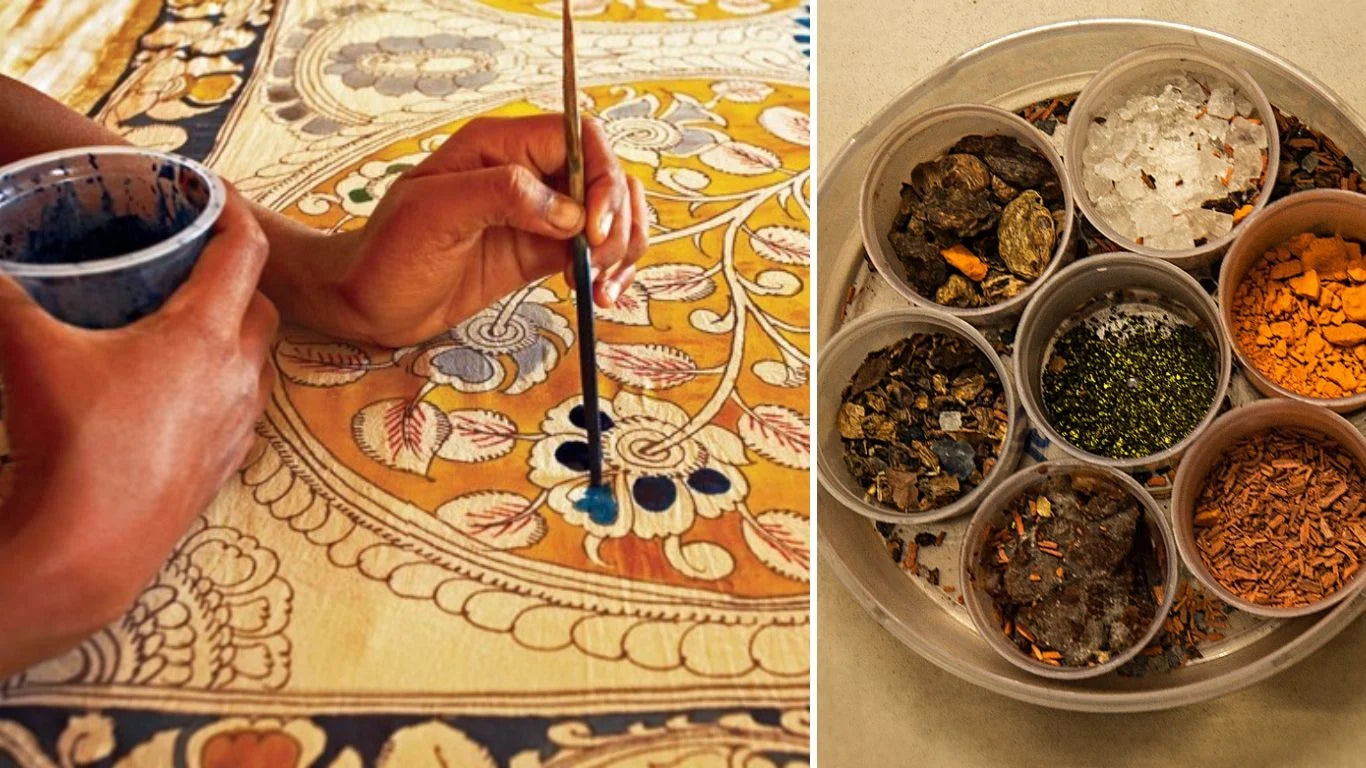
Image credit: Exotic indian art
3. Cultural and Artistic Value
-
Every item has great cultural value; it frequently tells tales from antiquated epics or features customary Indian plants and animals. Because of the talent and passion of the artisans, each piece of Kalamkari craft is a one-of-a-kind representation of India's rich heritage.
-
Wearing Kalamkari prints is more than just a chic addition to your wardrobe; it's a way to support a timeless art form and embrace a rich tradition.
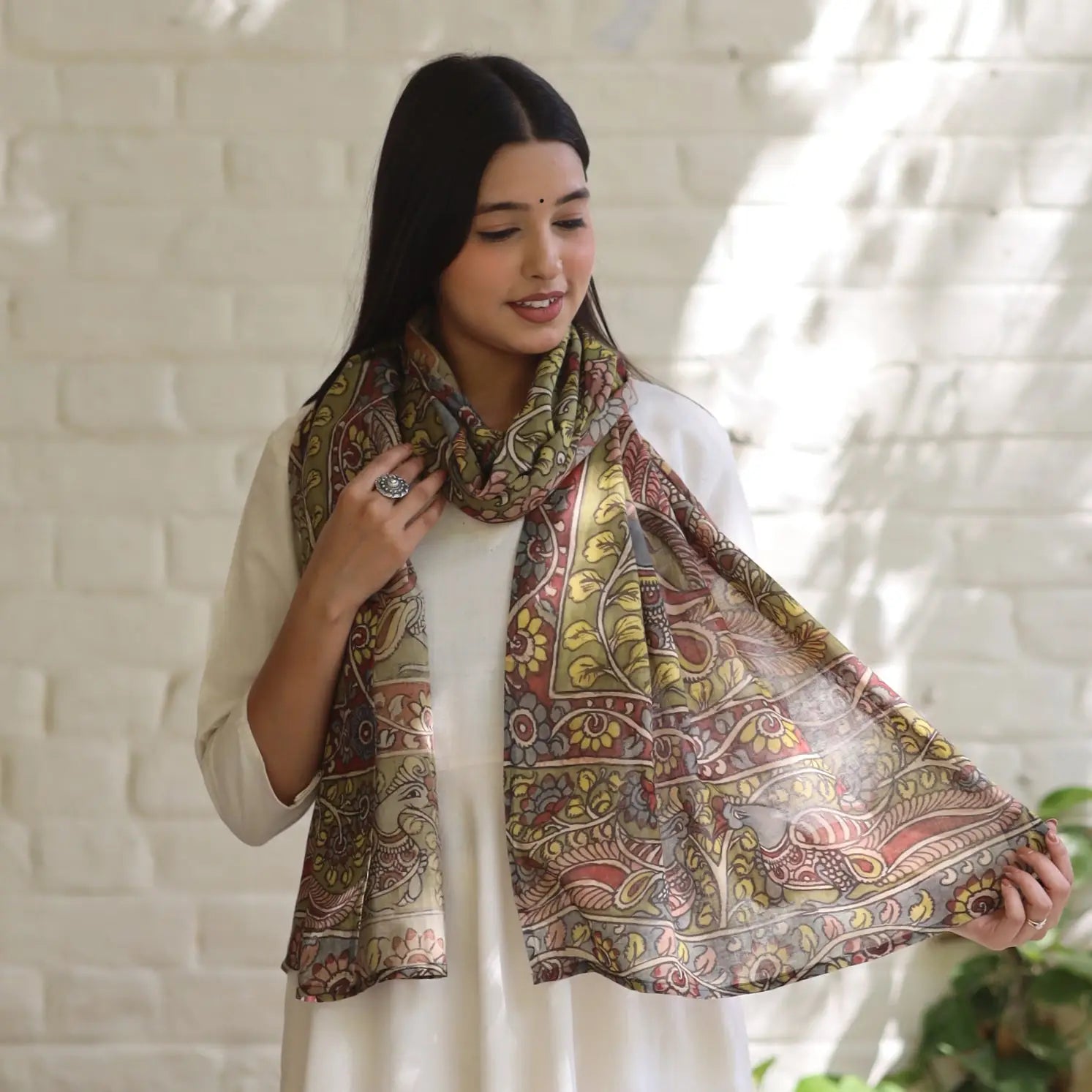
4. Durability and Versatility
-
Kalamkari prints are made to last, in addition to being exquisite to look at. Your vibrant colours will endure over time because the natural dyes utilised are excellent at withstanding fading.
-
Furthermore, Kalamkari printing is a practical option for making clothes to home décor because the textiles, which are usually cotton or silk, are chosen for their tenacity.
-
The finest aspect? Its adaptable patterns make Kalamkari a classic piece for your wardrobe because they go well with both traditional and modern looks. With its longevity and flair, Kalamkari textiles have you covered whether you're updating or decorating your house.
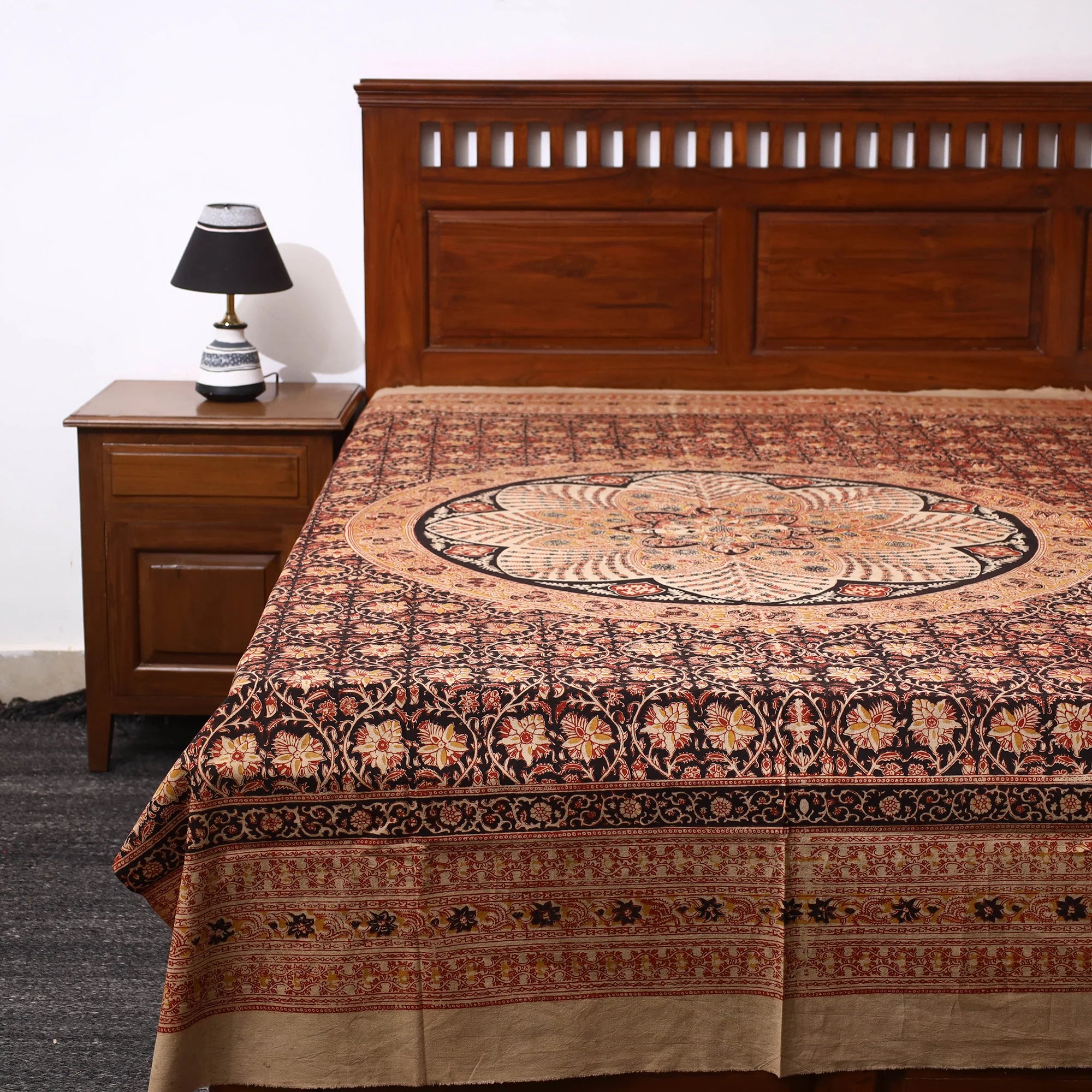
Themes and Motifs Used In Kalamkari Art
Whether you are intrigued by mythological tales and epic depictions or drawn to floral patterns and earthy elegance, Kalamkari offers a visual language for every soul. Explore the themes made on Kalamkari handicrafts below:
-
Mythological Tales and Epics Depicted
From scenes of the Ramayana and Mahabharata to stories of Krishna, Shiva, and other deities, Kalamkari prints reflect the age-old narratives through intricate illustrations.
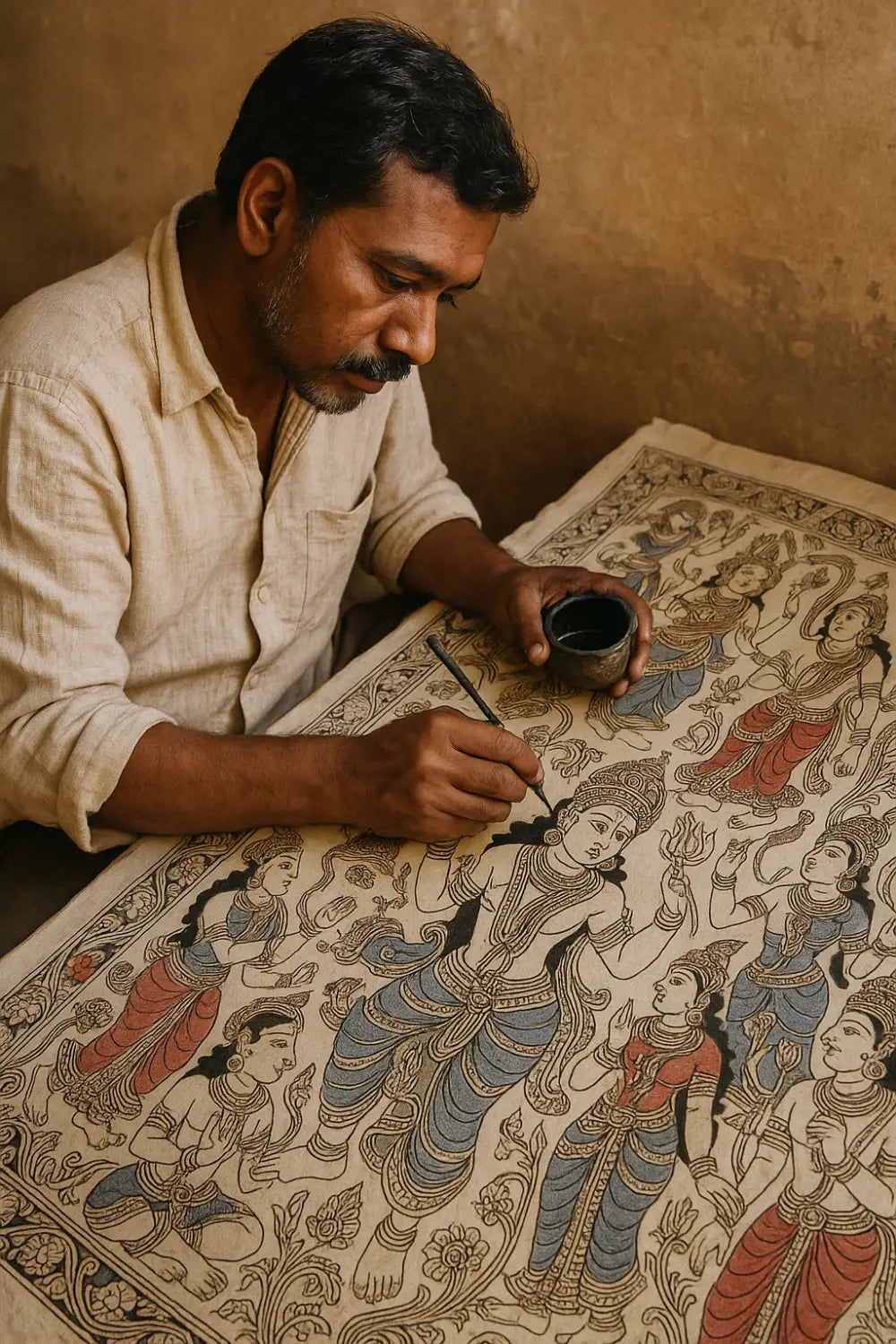
-
Floral, Animal, and Geometric Patterns
Inspired by nature, many Kalamkari patterns have depictions like blooming lotuses, dancing peacocks, and elegant vines which are often framed with harmonious geometric borders for balance and beauty.
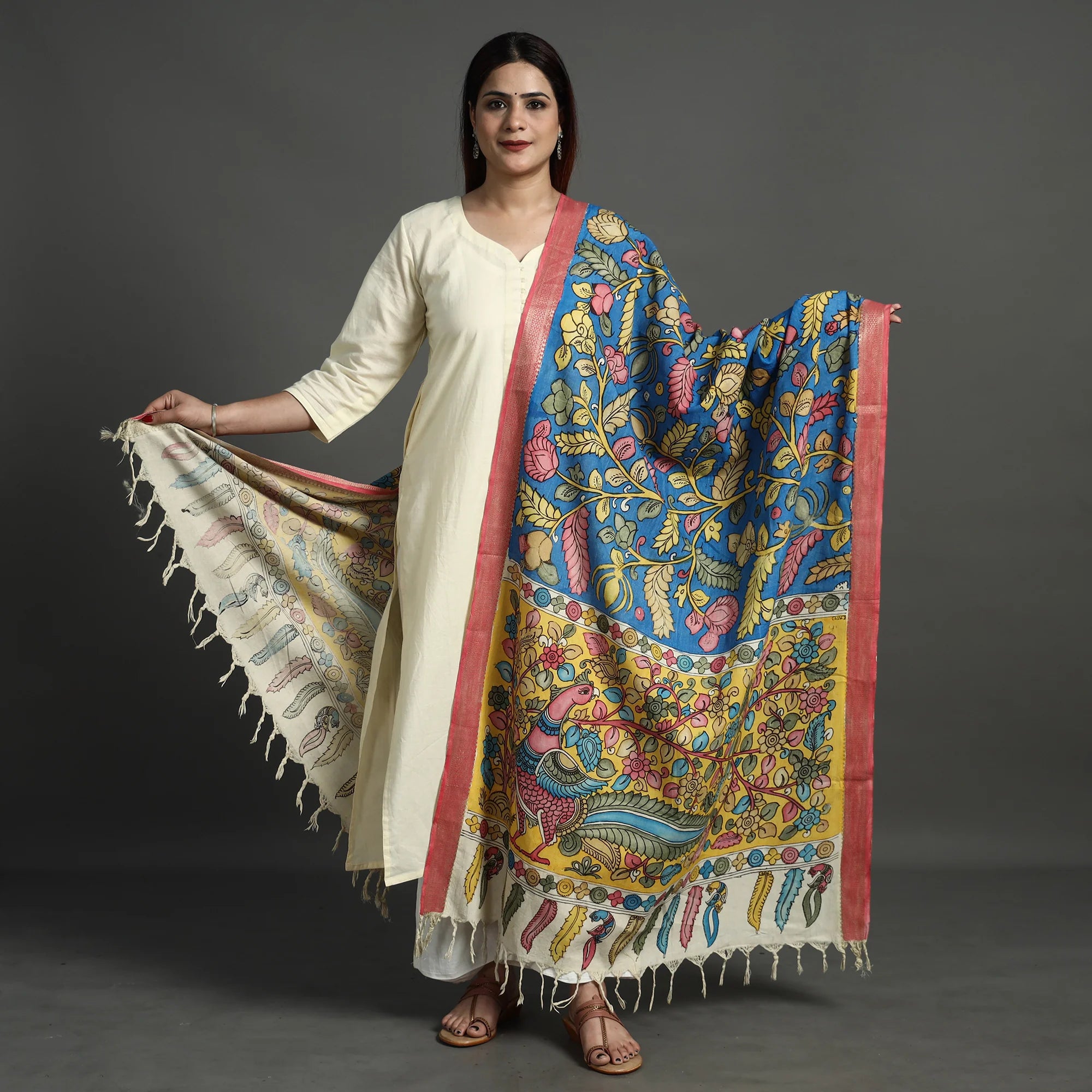
-
Religious and Spiritual Symbolism
Kalamkari art isn’t just decorative—it’s deeply symbolic. Motifs like the tree of life, conch shells, and mandalas reflect spiritual themes and a divine connection to nature.
Dreaming of pairing your plain, solid saree? Shop and explore our Kalamkari blouses for women.
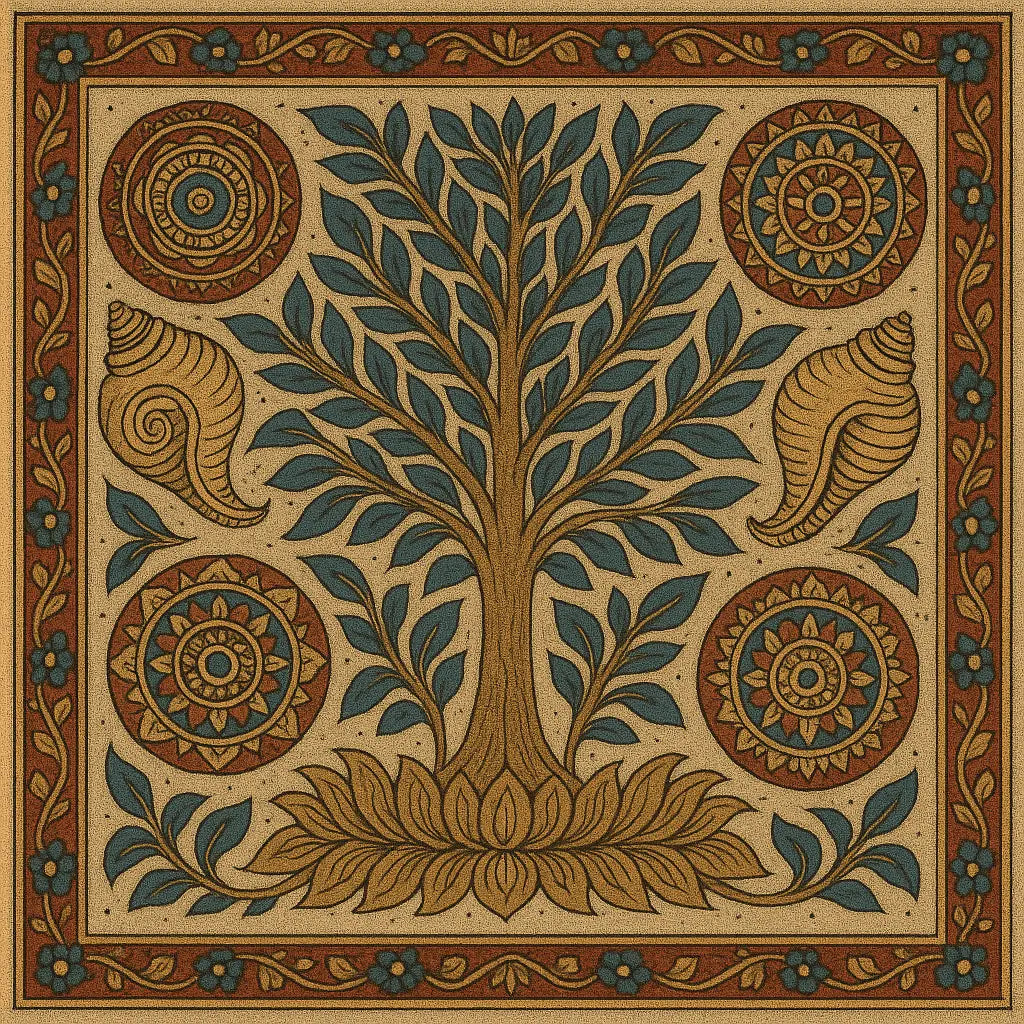
Has Kalamkari Got Its Geographical Indication (GI) Tag
Yes, Kalamkari art holds a proud place in India’s rich artistic legacy, and that honour was officially recognised in 2013 when the Pedana-style Kalamkari art, also known as the Machilipatnam style of Kalamkari, was awarded a Geographical Indication (GI) tag.
Here’s what the Kalamkari GI tag does:
-
It protects the authenticity of Kalamkari prints, materials, and local roots.
-
It ensures that Kalamkari art remains in the hands of its original artisans, the ones who preserve the cultural identity of Kalamkari printing history.
-
It highlights Kalamkari printing as one of India’s most treasured textile arts, which connects generations through stories, nature, and sacred symbols drawn in ink.
Also, shop for our hand-painted Kalamkari bangles for women.
How Is Kalamkari Made: The 23-Step Process
Soch ke dekhiye—23 steps, har ek filled with phoolon ki khushboo and artisan value. That’s Kalamkari art for you. Here’s how Kalamkari printing is done with 23 steps:
-
Step 1: Cow Dung & Bleach Soaking: Remove starch and natural oil from the fabric for better dye absorption.
-
Step 2: Complete Washing: Removes all material from the fabric again.
-
Step 3: Sun-Drying the Fabric: Naturally dries the cloth and prepares it for more treatment.
-
Step 4: Myrobalan (Harad) Treatment: Helps bind natural dyes to the fabric and leaves a subtle yellow colour.
-
Step 5: Dried the First Time: The Fabric dried again in the sun to set the myrobalan treatment.
-
Step 6: Hand Sketching with Kalam (Bamboo Pen): Artisans sketch with fine detail using a thin, pointed bamboo pen.
-
Step 7: Mordant Application: Natural mordants like alum are applied to fix dyes in specific areas.
-
Step 8: Mordant Dry Time: The fabric is left to dry so the mordants can properly react with the dye.
-
Step 9: Boiling in Alizarin: Mordant applied areas become a rich red colour or maroon.
-
Step 10: Rinsing & Sun-Drying: Excess dye is washed off, and the fabric is dried.
-
Step 11: Painting with Indigo Extract: Indigo is hand-painted where blue tones are needed in the design.
-
Step 12: Indigo Drying: Indigo areas dry properly to allow the full shade to fall out.
-
Step 13: Wax Resist Application: Wax is applied hot to protect dyeing in some areas.
-
Step 14: Yellow Dyeing (Turmeric, etc.): Add yellow hues using vegetable dyes, turmeric and others.
-
Step 15: Wax Removal in Hot Water: Boil fabric in hot water to remove the wax, not keeping white areas clear.
-
Step 16: Black Dye Application (Iron Solution)” Using the fermented iron solution, artisan paint with black details and outlines.
-
Step 17: Final Detailing and Touch-Up: Artisan adds final smaller motifs, lines, and patterns before it is done.
-
Step 18: Final Wash: Washes away unfixed excess dye.
-
Step 19: Stretching and flattening: The Fabric is stretched out to address creases and make sure the fabric is keeping its shape.
-
Step 20: Secondary Motifs Highlighted: More detailing is applied to add beauty and depth.
-
Step 21: Quality Checking: The artisan quality checks the cloth to make sure it is not a mistake (for example, lines in the wrong place or an error).
-
Step 22: The Fabric was ironed: The Kalamkari cloths are pressed to give it a neat, polished appearance.
-
Step 23. Fabric is Completed: The Kalamkari textile is now fully finished and ready to be turned into garments or sold as it is.
The Kalamkari art entails 23 steps such as bleaching, dyeing, starching, block printing, hand printing and many more. (2)
How to Identify Authentic Kalamkari
With mass-produced replicas in the market, here's how you can ensure you're buying the real thing:
|
Feature |
Authentic Kalamkari |
Fake Prints |
|
Fabric |
Cotton/Silk |
Polyester blends |
|
Dyes |
Natural, earthy tones |
Synthetic, very bright colours |
|
Design |
Slight irregularities (a sign of handwork) |
Perfect symmetry, machine-like |
|
Smell |
Earthy (due to natural dyes) |
No natural smell or artificial scent |
Always choose platforms like iTokri, which work directly with artisan clusters and ensure authenticity.
As a designer, I’m always on the lookout for authentic handloom fabrics. iTokri’s Kalamkari fabric exceeded my expectations. The color didn’t bleed, the print was sharp, and my clients loved the final outfits. Will definitely reorder! - Pooja Sharma, Mumbai
Most Loved Kalamkari Products at iTokri
Whether you like to drape it, wear it, or twirl in it—iTokri’s Kalamkari collection has vibrant sarees, flowy skirts, classy co-ord sets and much more:
-
Kalamkari Saree: Ready to drape yourself in rich Indian art? Be the main character of your own story by adorning and exploring our Kalamkari sarees for women, as they bring out your best self.
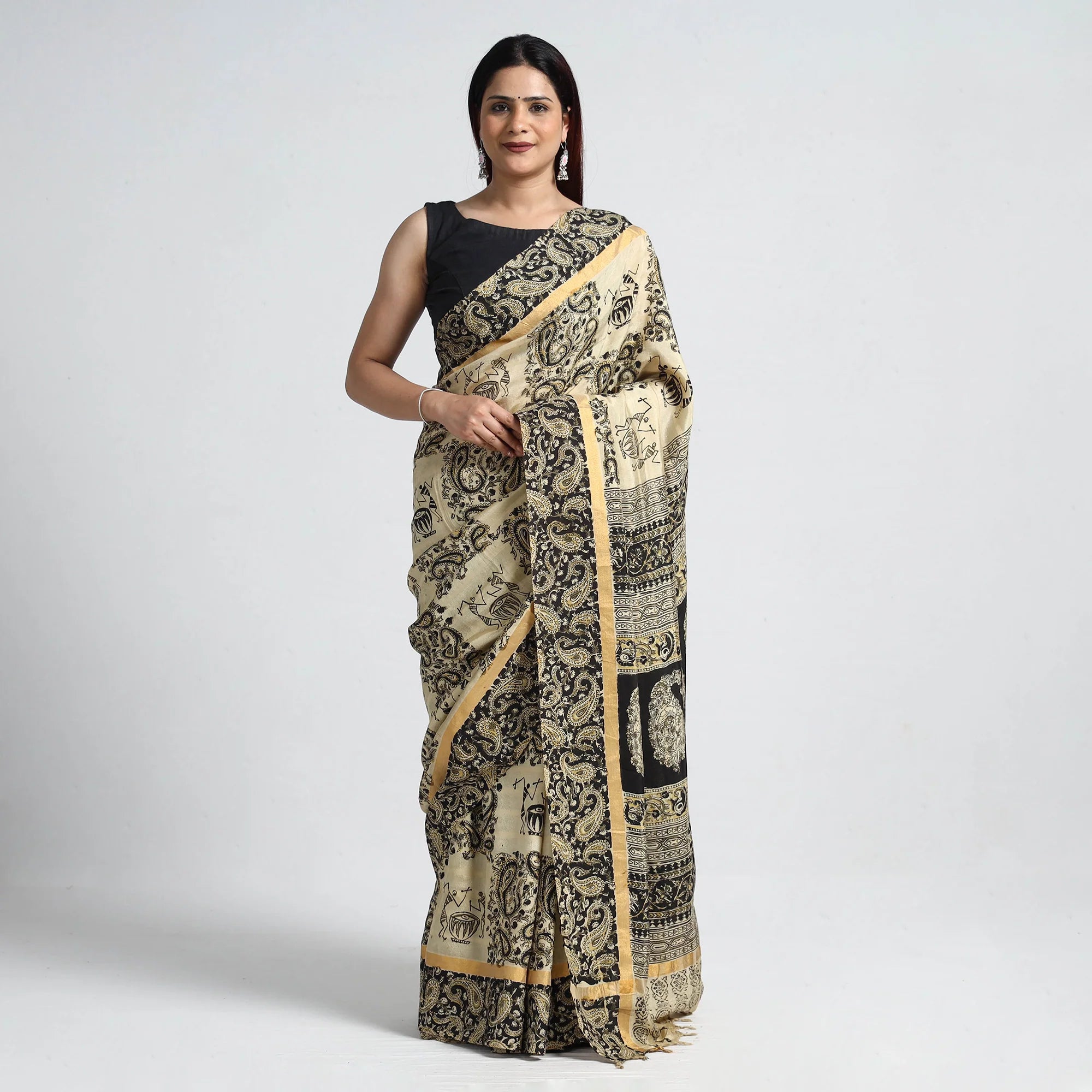
-
Kalamkari Dupatta: Looking to add that perfect pop of colour? Shop from our collection of Kalamkari dupattas for women that are light, lively, and full of heritage.
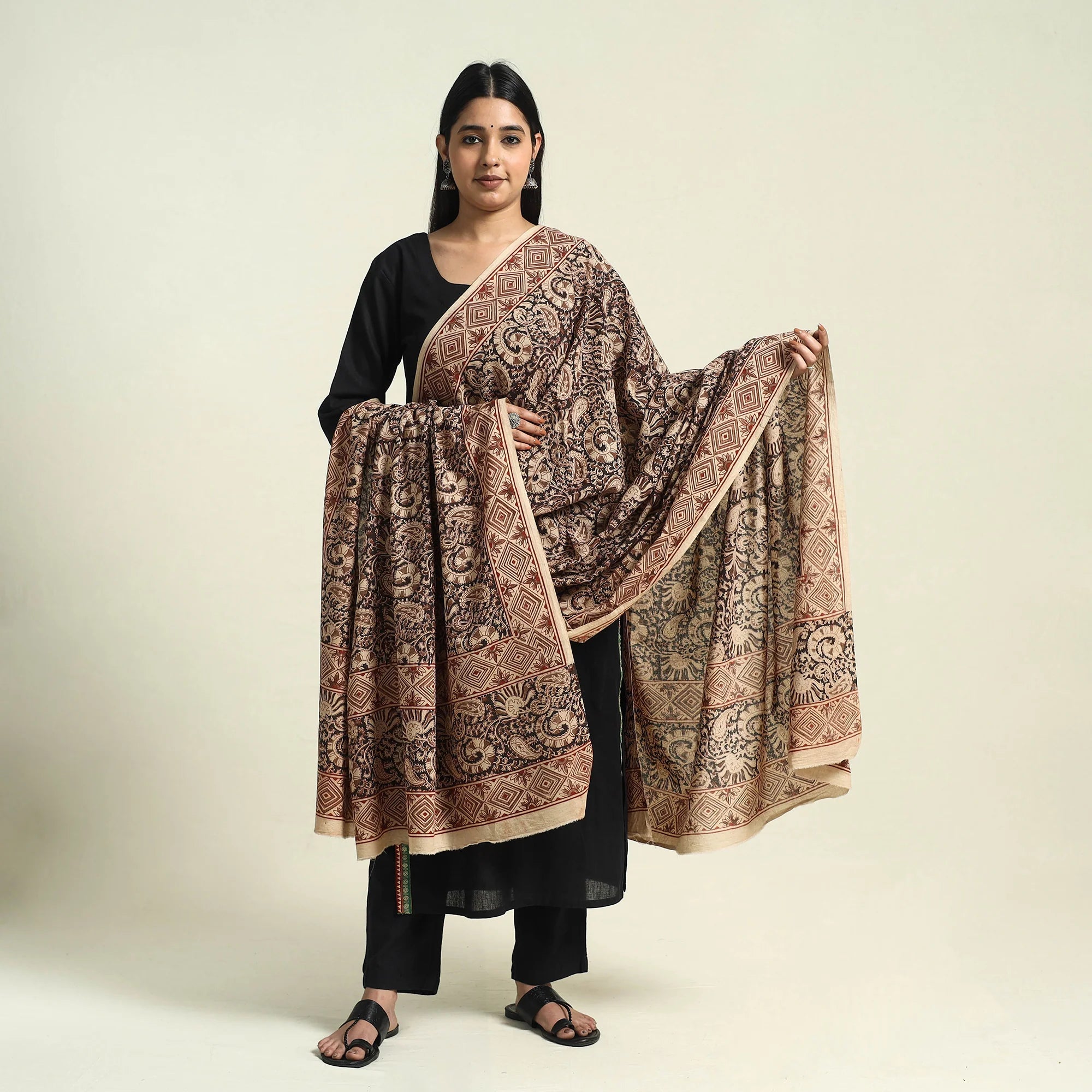
-
Kalamkari Dress Material: Ever dreamed of creating your own ethnic wear? Pure Kalamkari dress material online from iTokri is the best choice!
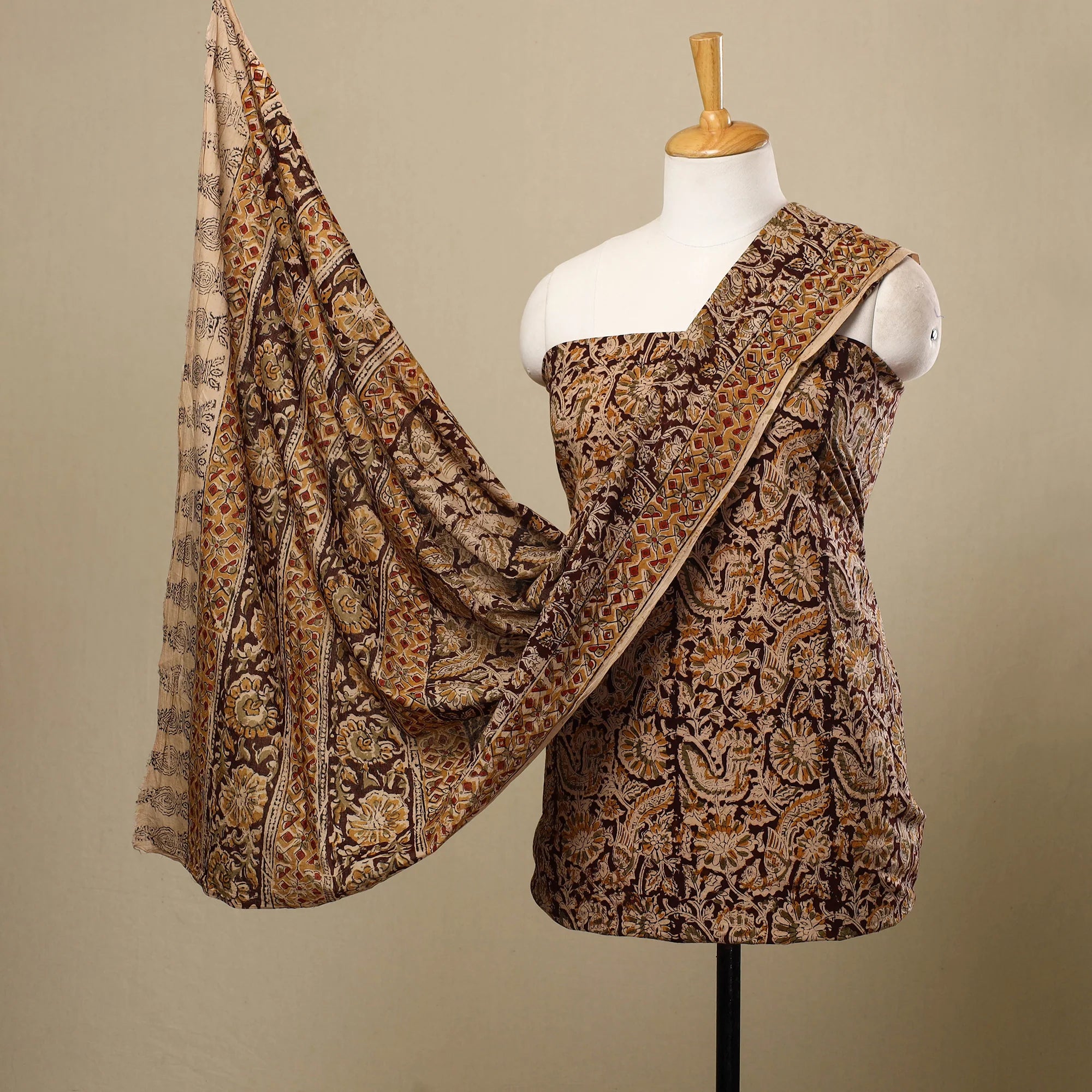
-
Kalamkari Kurtis: Looking for comfortable and stylish kurtis for your everyday wear? Kalamkari kurta sets for women from iTokri are made to fit your vibe perfectly!
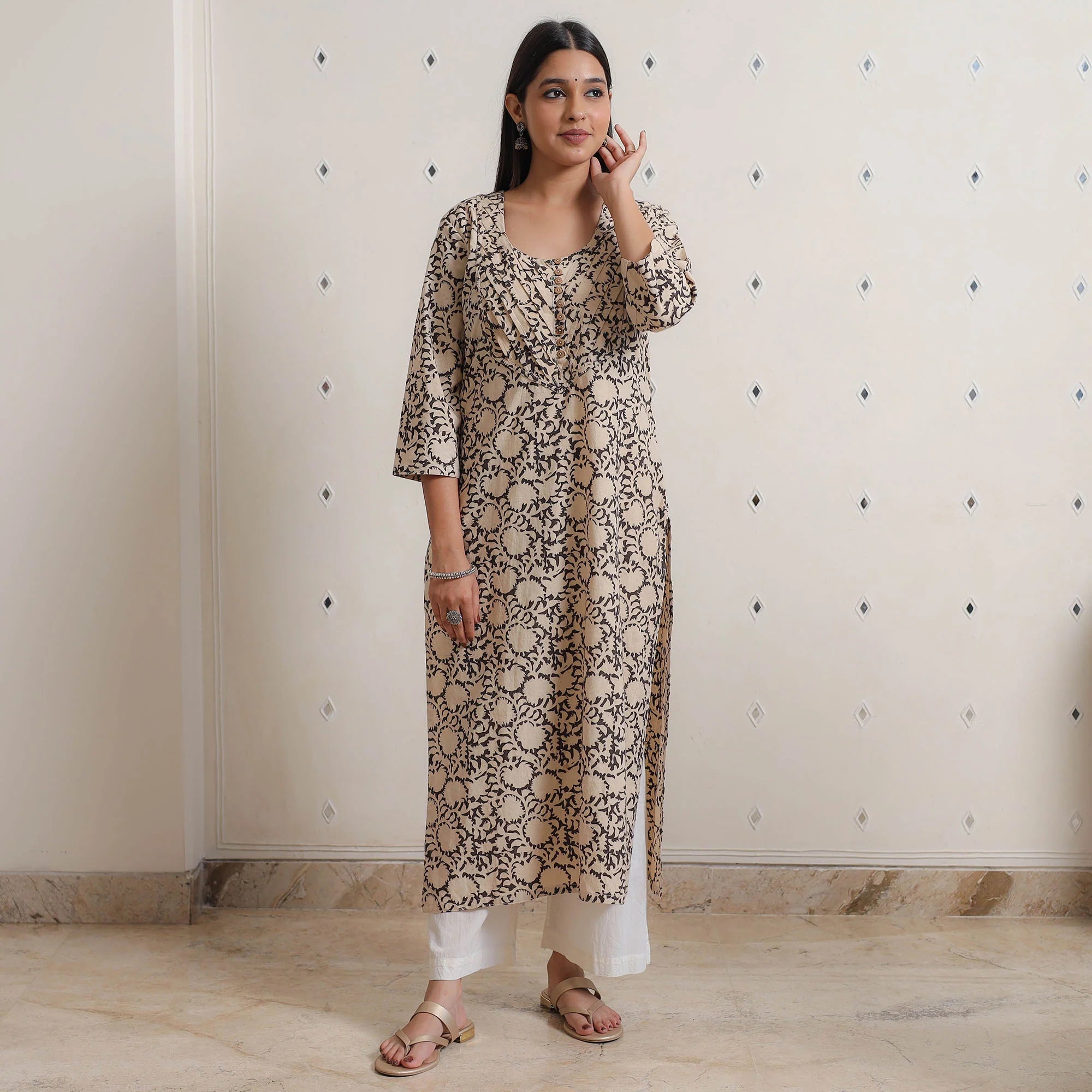
The Kalamkari kurta I bought is a perfect blend of comfort and tradition. It fits beautifully, and the earthy tones are so soothing. Kudos to iTokri for supporting Indian artisans! - Vandana Despande, Surat
-
Kalamkari Skirts & Co-ord Sets: Ready to twirl around your way? Want Kalamkari prints that move with you? Kalamkari skirts for women and Kalamkari women’s co-ord sets are calling you!
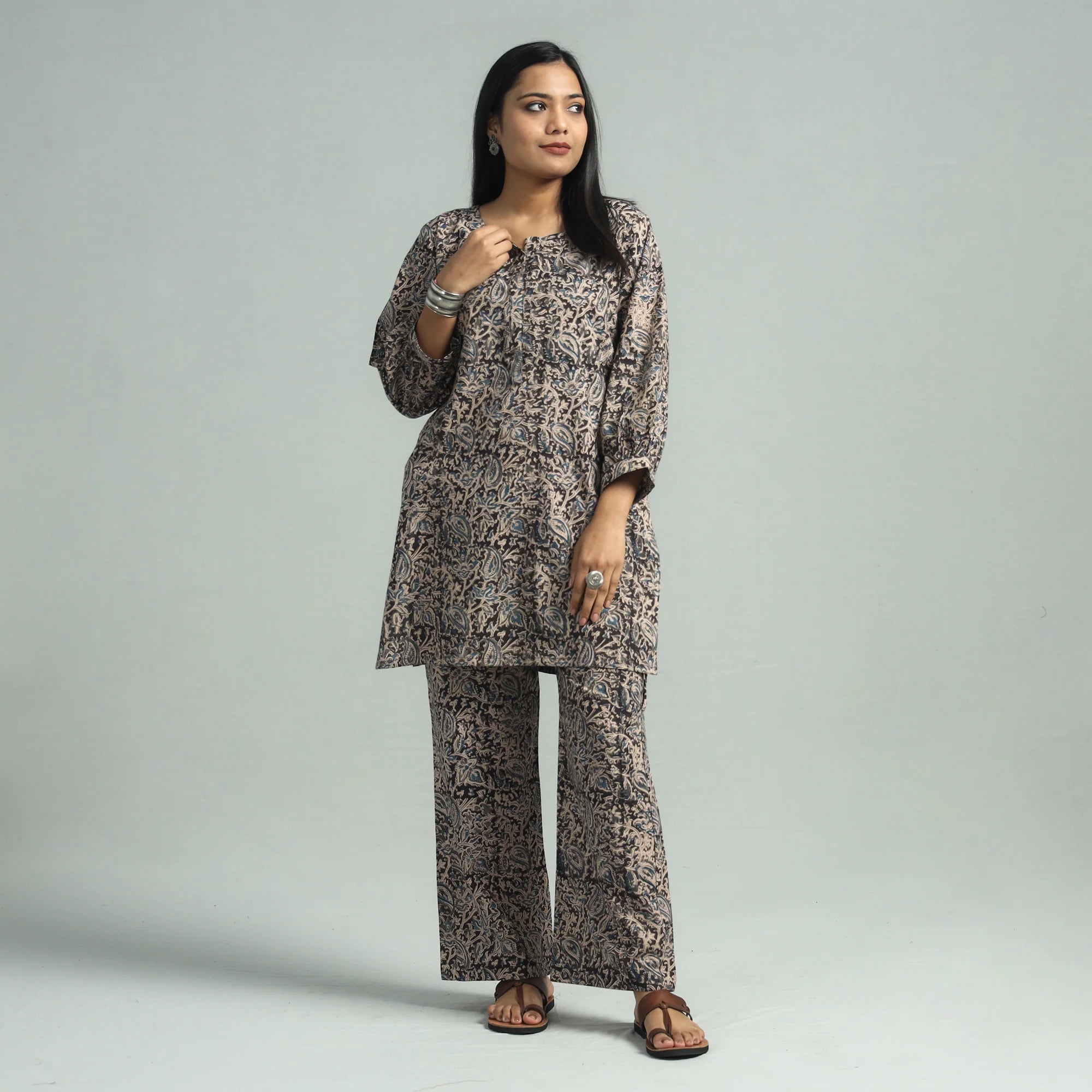
Don’t miss out on our Kalamkari shoulder bags for women.
Caring for Kalamkari Fabric
Since Kalamkari is made using natural dyes, proper care ensures longevity:
Hand wash separately in cold water using mild detergent.
Avoid direct sunlight for long hours to prevent fading.
Do not bleach or tumble dry.
Iron on low heat and store in a cool, dry place.
Why Kalamkari Fabrics Are a Must-Have for Your Wardrobe?
From being timeless in nature to skin-friendly, here’s why Kalamkari textiles or Kalamkari prints are a wardrobe must-have:
Timeless Elegance
Do you want to give your clothing a little more refinement? Kalamkari textiles, which can be block-printed or hand-painted, give your clothes a distinctive flair and transform each item into a work of wearable art. What's the best thing, then? You'll always be fashionable because of the fusion of classic themes and contemporary fashion trends.
Eco-friendly and Skin Safe
If you are concerned about environmentally friendly clothing, Kalamkari art is definitely for you. The natural dyes utilised are ideal for those with sensitive skin because they are not only kind to the skin but also sustainable.
Versatility in Fashion
Kalamkari prints are usually versatile. Kalamkari's varied patterns suit a wide range of preferences, whether you're looking for a striking saree, an elegant kurta, or even home décor pieces like cushions and curtains. Because of its versatility, which lets you mix and match to create new styles, it's ideal for both formal events and everyday wear.
Supporting Artisan Communities
Among the advantages of wearing Kalamkari clothing is... You're directly helping accomplished craftspeople who have been working in this field for many generations. Every purchase makes a difference in these communities by protecting their cultural heritage and guaranteeing the survival of this exquisite art form. A statement of craftsmanship and cultural pride, Kalamkari stands out in a world of mass-produced fashion.
iTokri and Kalamkari Fabrics - The Best Platform to Buy
If you’re thinking of where to buy authentic Kalamkari products online, iTokri is the perfect choice. Known for our curated collection of premium Indian handicrafts online, iTokri ensures every item is special and one-of-a-kind. We collaborate with skilled artisans who use eco-friendly techniques and keep ancient traditions alive. From providing free alteration services on selected crafts to embracing fair trade practices, iTokri stands as a testament of both authenticity and ethical craftsmanship. Connect with us through iTokri’s Instagram and look forward to loving client stories and more such crafts.
Conclusion
Kalamkari art provides something pleasantly unusual in a world where fast fashion frequently rules: a fusion of artistic tradition, environmental conscience, and adaptable fashion. No matter what draws you in—its elaborate patterns, rich history, or environmental friendliness—Kalamkari textiles are a significant and fashionable complement to every outfit. Thus, why not incorporate a bit of this rich cultural legacy into your collection? Your wardrobe will appreciate it, we promise!
Frequently Asked Questions On Kalamkari
1. What are the key features that define Kalamkari art?
Kalamkari art is known for its hand-drawn or block-printed designs, natural dyes, mythological themes, and detailed patterns.
2. What materials and dyes are used in traditional Kalamkari printing?
Natural cotton or silk fabrics are used, and the dyes come from plants, roots, flowers, and minerals, like indigo, pomegranate, and iron salts.
3. How is Kalamkari printing different from digital or screen prints?
Unlike machine-made digital prints, Kalamkari printing is done by hand, either with a bamboo pen or wooden blocks.
4. Does Kalamkari involve hand-painting, block printing, or both?
Both! Srikalahasti style uses hand-painting with a pen, while the Machilipatnam style of Kalamkari uses block printing.
5. What kind of motifs or stories are typically seen in Kalamkari art?
You’ll find gods, goddesses, scenes from epics like the Ramayana and Mahabharata, as well as floral vines, animals, and other natural elements on Kalamkari cloths.
6. Is Kalamkari print eco-friendly and safe for sensitive skin?
Yes! Since only natural dyes are used, Kalamkari prints are gentle on the skin and eco-friendly too.
7. How do I care for Kalamkari-printed garments to preserve their artistry?
Wash them gently by hand in cold water with mild detergent. Avoid direct sunlight when drying to keep the colours vibrant.
8. Is Kalamkari printing protected under a GI tag, and what does it signify?
Yes, the Machilipatnam style of Kalamkari holds a GI (Geographical Indication) tag. This means it's officially recognised as a traditional art form from a specific region, which helps preserve its authenticity and supports the artisans who create it.
Citations –
 Verified Purchase
Verified Purchase









































Leave a comment (all fields required)